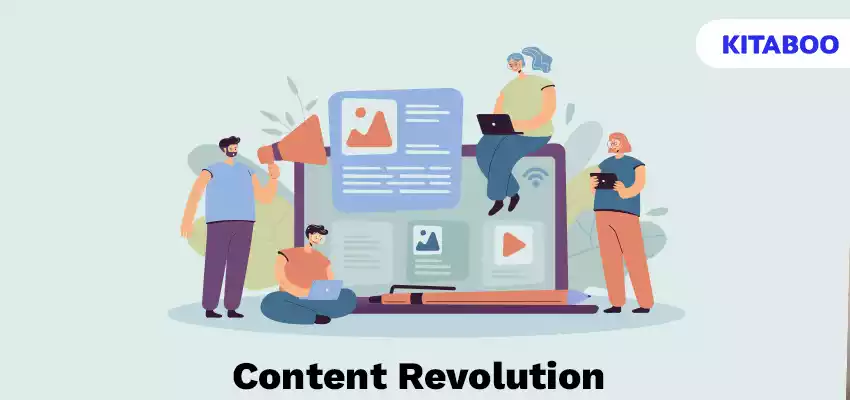
Content Revolution: Digital Publishing’s Global Influence
Summarize this blog with your favorite AI:
The publishing world has transformed immensely since moving from traditional print to digital platforms. This evolution of the global impact on digital publishing has revolutionized how we create, publish, share, distribute, and consume content.
Thanks to digital publishing solutions, content creators are empowered today to reach a wider audience by making their content available on various online platforms.
Subscription services and digital textbook platforms like KITABOO offer authors and publishers a broad reach and an established customer base. Such cloud-based applications use artificial intelligence and new marketing technologies to manage content operations. The number of organizations using AI for content creation and modification purposes has grown by 66% since 2021.
While technology is important, the processes you implement are crucial for the success of your content marketing efforts. This blog explores the relevance of content planning and how it drives a more effective content marketing strategy, thus leading to a robust global impact on digital publishing.
Table of Contents:
I. The Progression of Content in Digital Publishing
II. The Advantages of Encouraging Publishing Content Considering Digital Publishing’s Global Influence
- Enhances Credibility
- Boosts Search Engine Rankings
- Builds Relationships
- Cost-Effective
- Shareable on Social Media
III. 10 Ways Publishing Content Has Elevated the Global Impact on Digital Publishing
- Content Focuses on Clear Objectives
- Covers Current Trends
- Employing a Content Management System
- Serve Specific Objectives
- Test and Measure Content
- Integration of Multimedia
- Adaptation and Personalization
- Copyright and Piracy Concerns
- Importance of Reflowable Layout and Fixed Layout Publishing
- The Ability to Convert PDF files into ePUB format
IV. Conclusion
The Progression of Content in Digital Publishing
Here’s a quick overview of the progression of content from print to digital publishing:
- Phase 1 – Print was supreme! Before the digital era, print media was the main way information was shared. Newspapers, magazines, and traditional paperback books were essential for educational purposes, corporate learning, entertainment, and staying informed.
- Phase 2 – The late 1990s brought about an increase in online content with the rise of the internet.
- Phase 3 – The introduction of eBooks in the mid-2000s, owing to the launch of eReaders.
- Phase 4 – As technology progressed, interactive features and multimedia elements enhanced the reading experience, making content more dynamic.
- Phase 5 – The rise of smartphones and tablets led to mobile-friendly content.
- Future Trends in Digital Publishing – The future of content in digital publishing includes the usage of modern technologies like voice search, augmented reality, virtual reality, the Internet of Things (IoT), blockchain technology, ML and NLP, and content personalization with AI.
The Advantages of Encouraging Publishing Content Considering Digital Publishing's Global Influence
Here are some reasons why the modern digital publishing industry should focus on content:
1. Enhances Credibility
Content marketing positions you and your organization as thought leaders in your industry. Content informs your audience about your business and industry and provides valuable information to help customers make informed decisions.
2. Boosts Search Engine Rankings
Google is a massive search engine, and creating content optimized for relevant keywords helps you reach potential customers searching for information related to your industry.
Including immersive and interactive content, meaningful content that answers queries or resolves issues, and calls to action in your content helps convert leads to consumers.
3. Builds Relationships
Content just doesn’t promote your business to sell; it helps build long-lasting relationships. Providing valuable content shows your audience that you care about them, which builds trust and loyalty and can lead to more sales in the future.
4. Cost-Effective
Content formation, management, and marketing in the digital publishing arena are cost-effective, as it doesn’t require a big budget to produce high-quality content that engages customers. Valuable content across social media platforms and insightful blogs can achieve significant results.
5. Shareable on Social Media
Content is easily shareable on social media platforms and can strongly drive the global impact of digital publishing. Publishing content can amplify your reach and engagement. Utilizing various social networks can help promote content from your site to a wider audience. You can finally guide visitors towards taking action and becoming customers.
10 Ways Publishing Content Has Elevated the Global Impact on Digital Publishing
Let us look at important ways in which publishing content has revolutionized the digital publishing industry!
1. Content That Focuses on Clear Objectives
For each piece of content, whether it is for the educational industry, the business world, or the training sector, specific goals are aligned. This ensures that your team collaborates with a unified objective and target audience in mind for each content piece.
Content focuses on topic coverage and visibility, brand consistency and emotional connection, and finally, audience reach and engagement.
2. Covers Current Trends
One of the integral ways in which publishing content is augmenting the global impact of digital publishing is by adapting to changes, modern industry trends, and the latest consumer demands. Digital publishing incorporates the latest content after engaging with internal stakeholders, partners, and customers to stay updated on industry trends.
Popular tools, data analytics, content analytics metrics, and applications can be used to identify popular topics and keywords for both SEO and establishing thought leadership.
3. Employing a Content Management System
Industries today are evaluating the relevance of updated content and allocating resources and budgets for writers or agencies to address content gaps and trending topics. The capability of publishing solutions ensures the production of valuable content that enhances organic traffic, conversion rates, and brand awareness.
A content management system can provide a centralized platform for collaboration among stakeholders. Experimenting with different content strategies and utilizing a CMS can help publishing solutions manage an effective omnichannel content strategy.
4. Serve Specific Objectives
The content revolution in digital publishing focuses on addressing content gaps, tackling trending topics, utilizing available resources, and collaborating with digital channels.
With all these criteria met, you can publish the content that you know will have a positive impact. Before creating content, ensure you’re well-organized and have a plan in place for each piece. This ensures your content is well-written and effective for your audience.
5. Test and Measure Content
Testing and measuring the effects of your content helps organizations determine what’s working well and what areas need improvement. It helps assess whether your content is reaching your target audience and achieving the desired impact.
6. Integration of Multimedia
The integration of multimedia in digital publishing involves incorporating various multimedia elements. These elements include tables, diagrams, graphs, images, videos, infographics, audio, animations, and interactive graphics. This simplifies complex content, enriches the reader’s experience, and presents information in a better way.
As technology advances, multimedia shall have a more significant role in how publishing content is presented.
7. Adaptation and Personalization
Adaptation and personalization mean customizing the content according to individual preferences, needs, and behaviors. Digital platforms can dynamically update content in response to reader feedback and changing trends, ensuring its relevance.
68% of marketers are shifting towards the trend of offering personalized experiences. At the same time, 92% of businesses are using AI to offer personalized experiences.
Additionally, algorithms can personalize content recommendations based on user data analysis. Digital platforms offer innovative opportunities for content creators who now have the advantage of experimenting with innovative formats of writing content.
8. Copyright and Piracy Concerns
Copyright and piracy issues are significant challenges in digital publishing. The ease of copying and distributing digital content has raised concerns for publishers and consumers. Publishers must implement effective digital rights management systems using digital textbook platforms like KITABOO.
Such applications help fight externalities and protect publishing content to ensure fair compensation for authors. Some of the key concerns include:
- Unauthorized Distribution
- Plagiarism
- Complex Global Copyright Laws
- Digital Piracy
9. Importance of Reflowable Layout and Fixed Layout Publishing
Reflowable layout, also known as responsive design, allows content to adapt dynamically to different screen sizes and orientations. This flexibility ensures that readers can enjoy a seamless reading experience across various devices. A reflowable layout enables text to adjust automatically and is effective enough to reach a wider audience and accommodate diverse reading habits.
On the other hand, fixed layout publishing maintains the precise placement of text, which is particularly suitable for content that requires precise formatting.
Fixed layout publishing ensures that complex layouts and illustrations are reproduced on digital devices. Such experiences have elevated the global impact of digital publishing by offering versatility, accessibility, and enhanced user experiences.
10. The Ability to Convert PDF files into ePUB Format
ePUB format is widely supported across various digital devices. ePUB files automatically adjust to different screen sizes and ensure a smooth reading experience for users across devices.
Converting PDFs into ePUB format improves accessibility, supports interactive features, offers advanced search capabilities, and makes it easier for publishers to distribute content across various online platforms.
Also Read: Digital Content Evolution: Impacting Global Publishing Trends
Conclusion
The evolution of digital publishing showcases content’s remarkable impact and supremacy, which offers readers more immersive reading experiences. Publishing content offers increased accessibility, cost savings, and new creative opportunities.
KITABOO is a simple yet powerful digital textbook platform popular for its cloud-based and AI-empowered functionalities and resources. It elevates the content creation and digital publishing process.
Discover how a mobile-first training platform can help your organization.
KITABOO is a cloud-based platform to create, deliver & track mobile-first interactive training content.


![Top 5 Free Publishing Sites for Independent Publishing [2026]](https://kitaboo.com/wp-content/uploads/2025/09/Top-5-Free-Publishing-Sites-for-Independent-Publishing-2026-420x235.webp)
